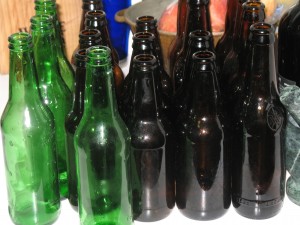Beer me, part 2
August 16, 2010
 [caption id="attachment_644" align="alignleft" width="300" caption="A picture, for ambiance."][/caption]
[caption id="attachment_644" align="alignleft" width="300" caption="A picture, for ambiance."][/caption]
(Note: this is a followup to this post.)
I wrote my last beer post having just finished bottling a new batch of beer.
After bottling, I waited a few more weeks for sediment in the beer to settle, and for the bacteria in the beer to convert the priming sugar (which I added just before bottling) into carbon dioxide.
Then - it was time to try it out! I’m not sure what to make of the results.
Most of the beer tasted pretty good, especially for the price ($30 of materials for 24 beers - let’s leave the time part of the calculation out, OK?). It definitely had a good amount of flavor, more than low-quality popular beers, though in general it definitely was not as good as any professionally-brewed beer I’ve tasted.
It’s not clear how high the alcohol level was! Nobody seemed to get a buzz off it, including me, and I’m pretty sensitive to alcohol. (When I made a batch last year, it definitely had some alcohol, though the flavor wasn’t as good).
Much of the beer was very well-carbonated. I wonder if I added too much sugar at the end, which perhaps even stopped the fermentation process? (To check: whether yeast prefer to metabolize priming sugar)
A few of the bottles, despite my concerted efforts, didn’t get capped properly. These bottles usually lost carbonation or had weird sediment in the bottle; though there is very little risk of dangerous contamination with beer, we didn’t open them.
There was a time lag of a couple weeks between the first couple bottles we tried, and the next ones. The beer seemed to improve somewhat in this time, though it’s not clear if this was instead due to differences in the contents of the particular bottles.
Overall, this was another good learning batch, but I apparently have a way to go before I produce beer with real culinary value. The fact that there were problems with carbonation level and alcohol content - and the fact that the alcohol content seemed to change as the beer aged - suggests to me that I need to develop a better understanding of the fermentation process and wait longer, in general, before bottling.
I also would like to learn how to use a hydrometer, which would give me information about the progress of fermentation, and alcohol content. As things stand now, I tend to just follow the instructions, whereas it is far more reliable to let actual measurements guide any process like this.
Finally, I am going to look into small batch brewing, and whether this is even possible. Rather than spend hours on brewing a massive batch once a year, it would be great if I could brew a batch of 4 - 6 bottles every month or so, to perfect my technique.